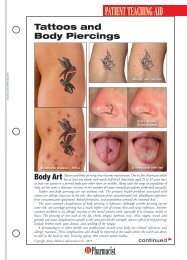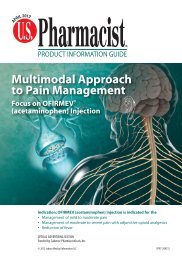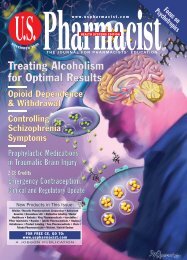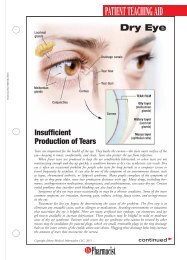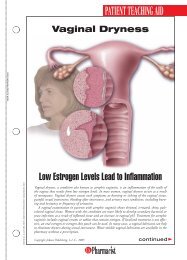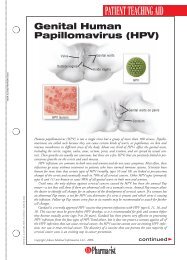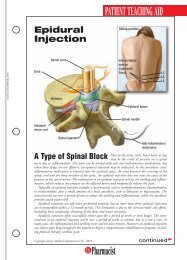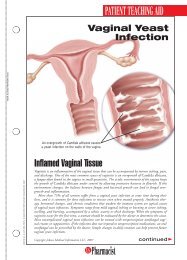View PDF Edition - U.S. Pharmacist
View PDF Edition - U.S. Pharmacist
View PDF Edition - U.S. Pharmacist
You also want an ePaper? Increase the reach of your titles
YUMPU automatically turns print PDFs into web optimized ePapers that Google loves.
BRIEF SUMMARY OF FULL PRESCRIBING INFORMATION for<br />
ULORIC ® (febuxostat) tablets<br />
INDICATIONS AND USAGE<br />
ULORIC ® is a xanthine oxidase (XO) inhibitor indicated for the chronic management<br />
of hyperuricemia in patients with gout.<br />
ULORIC is not recommended for the treatment of asymptomatic hyperuricemia.<br />
CONTRAINDICATIONS<br />
ULORIC is contraindicated in patients being treated with azathioprine, mercaptopurine,<br />
or theophylline [see Drug Interactions].<br />
WARNINGS AND PRECAUTIONS<br />
Gout Flare<br />
After initiation of ULORIC, an increase in gout flares is frequently observed. This<br />
increase is due to reduction in serum uric acid levels resulting in mobilization of<br />
urate from tissue deposits.<br />
In order to prevent gout flares when ULORIC is initiated, concurrent prophylactic<br />
treatment with an NSAID or colchicine is recommended.<br />
Cardiovascular Events<br />
In the randomized controlled studies, there was a higher rate of cardiovascular<br />
thrombo embolic events (cardiovascular deaths, non-fatal myocardial infarctions,<br />
and non-fatal strokes) in patients treated with ULORIC [0.74 per 100 P-Y<br />
(95% CI 0.36-1.37)] than allopurinol [0.60 per 100 P-Y (95% CI 0.16-1.53)] [see<br />
Adverse Reactions]. A causal relationship with ULORIC has not been established.<br />
Monitor for signs and symptoms of myocardial infarction (MI) and stroke.<br />
Liver Enzyme Elevations<br />
During randomized controlled studies, transaminase elevations greater than 3 times<br />
the upper limit of normal (ULN) were observed (AST: 2%, 2%, and ALT: 3%, 2%<br />
in ULORIC and allopurinol-treated patients, respectively). No dose-effect<br />
relationship for these transaminase elevations was noted. Laboratory<br />
assessment of liver function is recommended at, for example, 2 and 4 months<br />
following initiation of ULORIC and periodically thereafter.<br />
ADVERSE REACTIONS<br />
Clinical Trials Experience<br />
Because clinical trials are conducted under widely varying conditions, adverse<br />
reaction rates observed in the clinical trials of a drug cannot be directly compared<br />
to rates in the clinical trials of another drug and may not reflect the rates observed<br />
in practice.<br />
A total of 2757 subjects with hyperuricemia and gout were treated with ULORIC<br />
40 mg or 80 mg daily in clinical studies. For ULORIC 40 mg, 559 patients<br />
were treated for 6 months. For ULORIC 80 mg, 1377 subjects were treated for<br />
6 months, 674 patients were treated for 1 year and 515 patients were treated<br />
for 2 years.<br />
Most Common Adverse Reactions<br />
In three randomized, controlled clinical studies (Studies 1, 2 and 3), which were<br />
6 to 12 months in duration, the following adverse reactions were reported by<br />
the treating physician as related to study drug. Table 1 summarizes adverse<br />
reactions reported at a rate of at least 1% in ULORIC treatment groups and at<br />
least 0.5% greater than placebo.<br />
Table 1: Adverse Reactions Occurring in 1% of ULORIC-Treated<br />
Patients and at Least 0.5% Greater than Seen in Patients<br />
Receiving Placebo in Controlled Studies<br />
Placebo ULORIC allopurinol*<br />
40 mg 80 mg<br />
daily daily<br />
Adverse Reactions (N=134) (N=757) (N=1279) (N=1277)<br />
Liver Function<br />
Abnormalities<br />
0.7% 6.6% 4.6% 4.2%<br />
Nausea 0.7% 1.1% 1.3% 0.8%<br />
Arthralgia 0% 1.1% 0.7% 0.7%<br />
Rash 0.7% 0.5% 1.6% 1.6%<br />
* Of the subjects who received allopurinol, 10 received 100 mg, 145 received<br />
200 mg, and 1122 received 300 mg, based on level of renal impairment.<br />
The most common adverse reaction leading to discontinuation from therapy<br />
was liver function abnormalities in 1.8% of ULORIC 40 mg, 1.2% of ULORIC<br />
80 mg, and in 0.9% of allopurinol-treated subjects.<br />
In addition to the adverse reactions presented in Table 1, dizziness was reported<br />
in more than 1% of ULORIC-treated subjects although not at a rate more than<br />
0.5% greater than placebo.<br />
Less Common Adverse Reactions<br />
In phase 2 and 3 clinical studies the following adverse reactions occurred in less<br />
than 1% of subjects and in more than one subject treated with doses ranging from<br />
40 mg to 240 mg of ULORIC. This list also includes adverse reactions (less than<br />
1% of subjects) associated with organ systems from Warnings and Precautions.<br />
Blood and Lymphatic System Disorders: anemia, idiopathic thrombocytopenic<br />
purpura, leukocytosis/leukopenia, neutropenia, pancytopenia, splenomegaly,<br />
throm bo cytopenia; Cardiac Disorders: angina pectoris, atrial fibrillation/flutter,<br />
cardiac murmur, ECG abnormal, palpitations, sinus bradycardia, tachycardia;<br />
Ear and Labyrinth Disorders: deafness, tinnitus, vertigo; Eye Disorders: vision<br />
blurred; Gastrointestinal Disorders: abdominal distention, abdominal pain,<br />
constipation, dry mouth, dyspepsia, flatulence, frequent stools, gastritis,<br />
gastro esophageal reflux disease, gastrointestinal discomfort, gingival pain,<br />
haematemesis, hyperchlorhydria, hematochezia, mouth ulceration, pancreatitis,<br />
peptic ulcer, vomiting; General Disorders and Administration Site Conditions:<br />
asthenia, chest pain/discomfort, edema, fatigue, feeling abnormal, gait<br />
disturbance, influenza-like symptoms, mass, pain, thirst; Hepatobiliary<br />
Disorders: cholelithiasis/cholecystitis, hepatic steatosis, hepatitis, hepatomegaly;<br />
Immune System Disorder: hypersensitivity; Infections and Infestations: herpes<br />
zoster; Procedural Complications: contusion; Metabolism and Nutrition Disorders:<br />
anorexia, appetite decreased/increased, dehydration, diabetes mellitus, hypercholesterolemia,<br />
hyperglycemia, hyperlipidemia, hypertriglyceridemia, hypokalemia,<br />
weight decreased/increased; Musculoskeletal and Connective Tissue Disorders:<br />
arthritis, joint stiffness, joint swelling, muscle spasms/twitching/tightness/weakness,<br />
musculoskeletal pain/stiffness, myalgia; Nervous System Disorders: altered<br />
taste, balance disorder, cerebrovascular accident, Guillain-Barré syndrome, headache,<br />
hemiparesis, hypoesthesia, hyposmia, lacunar infarction, lethargy, mental<br />
impairment, migraine, paresthesia, somnolence, transient ischemic attack,<br />
tremor; Psychiatric Disorders: agitation, anxiety, depression, insomnia, irritability,<br />
libido decreased, nervousness, panic attack, personality change; Renal and<br />
Urinary Disorders: hematuria, nephrolithiasis, pollakiuria, proteinuria, renal<br />
failure, renal insufficiency, urgency, incontinence; Reproductive System and<br />
Breast Changes: breast pain, erectile dysfunction, gynecomastia; Respiratory,<br />
Thoracic and Mediastinal Disorders: bronchitis, cough, dyspnea, epistaxis,<br />
nasal dryness, paranasal sinus hypersecretion, pharyngeal edema, respiratory<br />
tract congestion, sneezing, throat irritation, upper respiratory tract infection;<br />
Skin and Subcutaneous Tissue Disorders: alopecia, angio edema, dermatitis,<br />
dermographism, ecchymosis, eczema, hair color changes, hair growth abnormal,<br />
hyperhidrosis, peeling skin, petechiae, photosensitivity, pruritus, purpura, skin<br />
discoloration/altered pigmentation, skin lesion, skin odor abnormal, urticaria;<br />
Vascular Disorders: flushing, hot flush, hypertension, hypotension; Laboratory<br />
Parameters: activated partial thromboplastin time prolonged, creatine increased,<br />
bicarbonate decreased, sodium increased, EEG abnormal, glucose increased,<br />
cholesterol increased, triglycerides increased, amylase increased, potassium<br />
increased, TSH increased, platelet count decreased, hematocrit decreased, hemoglobin<br />
decreased, MCV increased, RBC decreased, creatinine increased, blood urea<br />
increased, BUN/creatinine ratio increased, creatine phosphokinase (CPK) increased,<br />
alkaline phosphatase increased, LDH increased, PSA increased, urine output<br />
increased/decreased, lymphocyte count decreased, neutrophil count decreased,<br />
WBC increased/decreased, coagulation test abnormal, low density lipoprotein<br />
(LDL) increased, prothrombin time prolonged, urinary casts, urine positive for<br />
white blood cells and protein.<br />
Cardiovascular Safety<br />
Cardiovascular events and deaths were adjudicated to one of the pre-defined<br />
endpoints from the Anti-Platelet Trialists’ Collaborations (APTC) (cardiovascular<br />
death, non-fatal myocardial infarction, and non-fatal stroke) in the randomized<br />
controlled and long-term extension studies. In the Phase 3 randomized controlled<br />
studies, the incidences of adjudicated APTC events per 100 patient-years of exposure<br />
were: Placebo 0 (95% CI 0.00-6.16), ULORIC 40 mg 0 (95% CI 0.00-1.08),<br />
ULORIC 80 mg 1.09 (95% CI 0.44-2.24), and allopurinol 0.60 (95% CI<br />
0.16-1.53).<br />
In the long-term extension studies, the incidences of adjudicated APTC events were:<br />
ULORIC 80 mg 0.97 (95% CI 0.57-1.56), and allopurinol 0.58 (95% CI 0.02-3.24).<br />
Overall, a higher rate of APTC events was observed in ULORIC than in allopurinoltreated<br />
patients. A causal relationship with ULORIC has not been established.<br />
Monitor for signs and symptoms of MI and stroke.<br />
DRUG INTERACTIONS<br />
Xanthine Oxidase Substrate Drugs<br />
ULORIC is an XO inhibitor. Drug interaction studies of ULORIC with drugs that<br />
are metabolized by XO (e.g., theophylline, mercaptopurine, azathioprine) have<br />
not been conducted. Inhibition of XO by ULORIC may cause increased plasma<br />
concentrations of these drugs leading to toxicity [see Clinical Pharmacology].<br />
ULORIC is contraindicated in patients being treated with azathioprine,<br />
mercaptopurine, or theophylline [see Contraindications].<br />
Cytotoxic Chemotherapy Drugs<br />
Drug interaction studies of ULORIC with cytotoxic chemotherapy have not been<br />
conducted. No data are available regarding the safety of ULORIC during<br />
cytotoxic chemotherapy.<br />
In Vivo Drug Interaction Studies<br />
Based on drug interaction studies in healthy subjects, ULORIC does not have<br />
clinically significant interactions with colchicine, naproxen, indomethacin,<br />
hydrochlorothiazide, warfarin or desipramine. Therefore, ULORIC may be used<br />
concomitantly with these medications.




